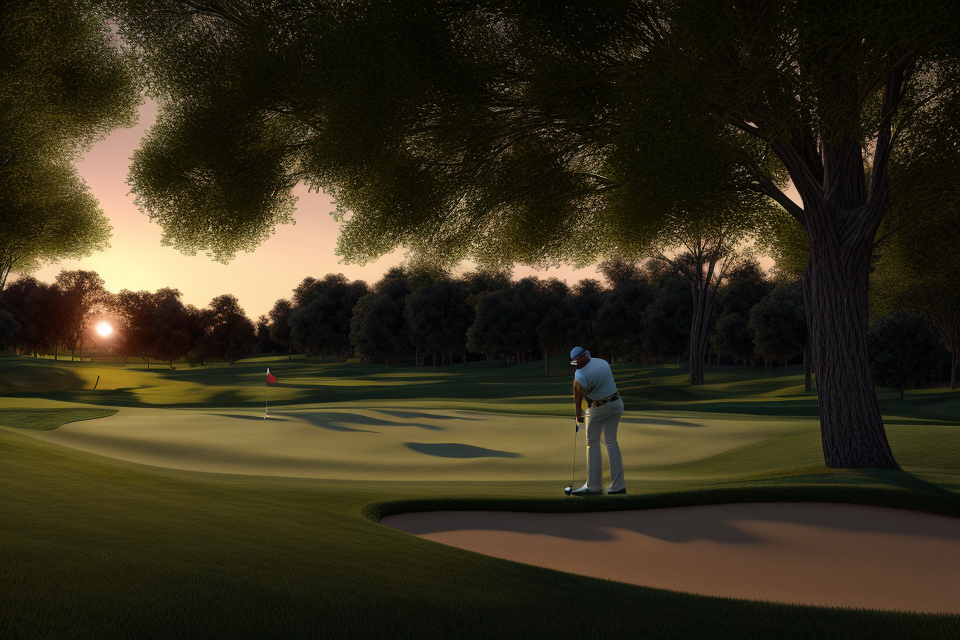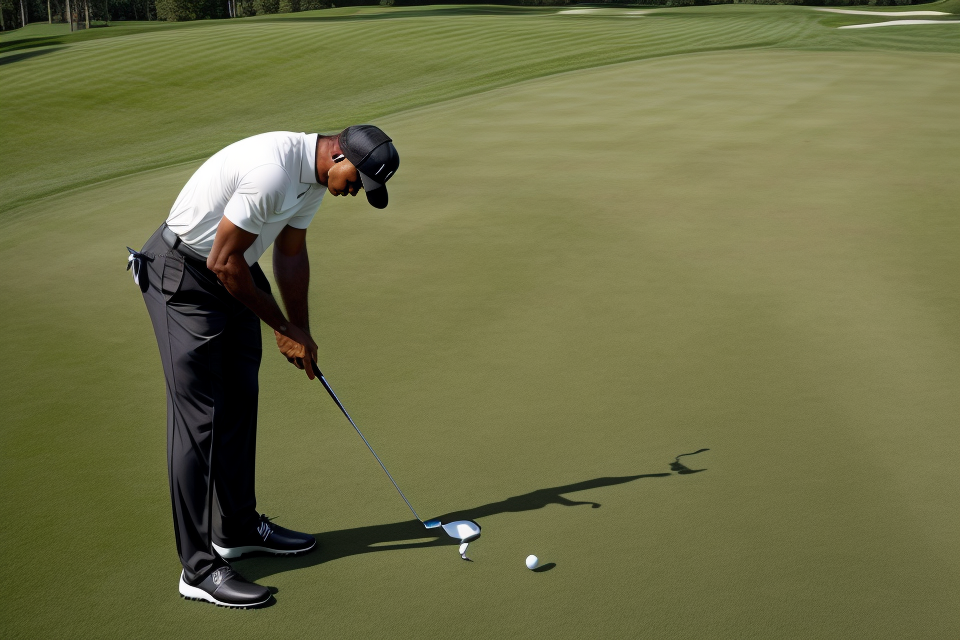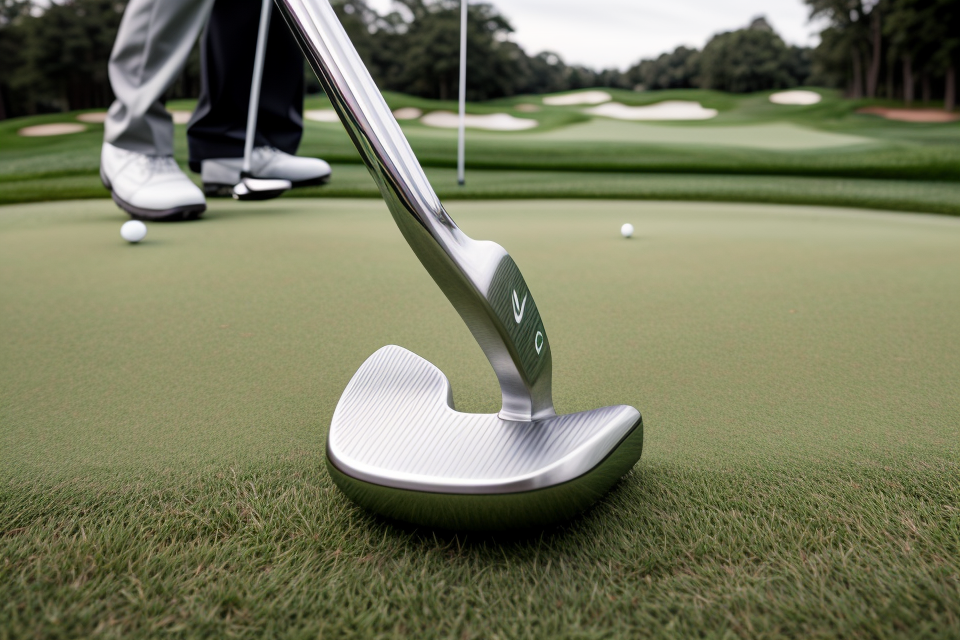
“Putt like a pro with the lab putter! Learn the techniques and strategies to master the art of putting. This essential guide will help you understand the physics behind the shot and give you tips to improve your accuracy. From grip to stance, you’ll discover the secrets to making those crucial putts. So, whether you’re a beginner or an experienced golfer, get ready to take your putting skills to the next level with the lab putter.”
The Basics of Putt
Understanding the Physics of Putt
Putt, the short game of golf, requires an understanding of the physics behind it to master the art. Here are some of the key concepts that you need to understand:
- Ball Roll and Friction: The ball roll and friction are two important factors that affect the accuracy and momentum of the putt. The ball’s roll is influenced by the friction between the ball and the green, and the speed at which it is rolling. A better understanding of these factors can help you control the direction and speed of the ball.
- Putt Momentum and Accuracy: The momentum and accuracy of a putt are crucial to making a successful shot. The momentum of the putt is determined by the speed and direction of the ball, while accuracy is determined by the path of the ball and the aim of the putter. By understanding the physics behind these factors, you can adjust your technique to achieve the desired outcome.
It is important to note that the physics of putt can be affected by various factors such as the surface of the green, the type of grass, and the weather conditions. Therefore, it is essential to take these factors into account when trying to master the art of putt.
Choosing the Right Putter
Choosing the right putter is crucial for a successful golf game. A putter that is not well-suited to your style or the green conditions can lead to missed putts and a frustrating round. In this section, we will discuss the different components of a putter and how to choose the right one for your game.
Putter Materials
Putters come in a variety of materials, including metal, graphite, and composite. Each material has its own advantages and disadvantages. Metal putters are typically heavier and provide a more stable feel, but they can be more difficult to control. Graphite putters are lighter and provide a more responsive feel, but they may not be as stable on longer putts. Composite putters offer a balance of weight and feel, but they can be more expensive than other materials.
Putter Shafts
The shaft of a putter is another important consideration. The most common materials for putter shafts are steel and graphite. Steel shafts are heavier and provide a more stable feel, while graphite shafts are lighter and offer a more responsive feel. Some putters also come with adjustable shafts, which allow you to adjust the length and weight of the shaft to suit your preference.
Putter Heads
The putter head is the part of the club that comes into contact with the ball. Different putter heads have different shapes and weights, which can affect the trajectory and roll of the ball. Some putter heads are designed to help with alignment, while others are designed to help with distance control. When choosing a putter head, it’s important to consider your personal preferences and the conditions of the green.
In addition to these factors, it’s also important to consider your own playing style and any physical limitations you may have. For example, if you have a slower swing speed, you may want to choose a heavier putter to help with accuracy. If you have a tendency to slice the ball, you may want to choose a putter with a more forgiving head design.
Ultimately, the right putter for you will depend on a variety of factors, including your personal preferences, the conditions of the green, and your playing style. Taking the time to choose the right putter can help you improve your accuracy and enjoy a more successful round of golf.
The Proper Stance and Alignment
The Importance of Posture
Proper posture is essential for an effective and consistent putting stroke. It sets the foundation for a smooth and accurate putt, ensuring that the body’s movements are in sync with the intended target. To maintain the correct posture, golfers should pay attention to the following aspects:
- Maintaining a Straight Back: A straight back is crucial for a proper putting stance. It helps to create a stable base, allowing the golfer to control the putter’s movement and keep the head steady throughout the stroke. A bent back can lead to a jerky and unpredictable putt, making it difficult to achieve accuracy.
- Proper Shoulder Alignment: The shoulders play a vital role in the putting motion. They should be aligned parallel to the intended target line, creating a straight and balanced stance. Misaligned shoulders can cause the golfer to slide or rotate during the putt, affecting the accuracy and consistency of the stroke.
By focusing on maintaining a straight back and proper shoulder alignment, golfers can establish a solid foundation for a successful putt. This posture not only helps to minimize unnecessary movements but also ensures that the putter’s path is in line with the target, ultimately resulting in more accurate and consistent putts.
Eye on the Ball
Maintaining focus is crucial when it comes to putting. A player’s eyes should be fixed on the ball from the moment they take their stance until the ball drops into the hole. This allows them to have a clear picture of the line they want to take and the speed at which they want to roll the ball.
Sighting the Line
Before taking a shot, players should survey the line they want to take and the path of the ball. They should imagine a straight line between the ball and the hole, and make sure that the putter is aligned along this line.
Maintaining Focus
Players should try to keep their attention on the ball at all times. They should avoid distractions such as the movements of other players or the sound of the wind. This helps them to stay focused on the task at hand and avoid any mental lapses that could affect their shot.
In addition, players should also practice visualization techniques, imagining the ball rolling towards the hole in slow motion. This helps to build muscle memory and improve the chances of making the shot. Overall, maintaining focus is a key aspect of mastering the art of putt.
The Stroke Technique
The Putt Grip
Fingers on the Putter
The placement of the fingers on the putter is a crucial aspect of the grip technique. Golfers typically place their fingers in the center of the putter, ensuring a firm and secure hold. This positioning allows for a stable and controlled stroke, minimizing the risk of twisting or torquing the putter during the swing. Additionally, keeping the fingers close to the top of the grip enables a smooth transition from the grip to the stroke, promoting a consistent and accurate putt.
Palms and Thumbs
The positioning of the palms and thumbs is also essential for a proper putt grip. The palms should be facing towards the target, providing a natural and comfortable grip on the putter. This positioning helps golfers maintain a neutral hand position, preventing any excessive rotation or tension in the hands.
The thumbs, on the other hand, should be placed in a strong and relaxed manner, with the top of the thumb resting lightly on the index finger. This thumb positioning ensures a firm grip on the putter, allowing for a smooth and controlled stroke. It is important to note that the thumbs should not be anchored or locked, as this can lead to tension and a loss of control during the putt.
Overall, the proper placement of the fingers, palms, and thumbs on the putter is crucial for a stable and accurate putt. Golfers should focus on maintaining a neutral and relaxed grip, with a firm hold on the putter and a smooth transition from the grip to the stroke. Mastering the art of the putt grip is a vital aspect of improving one’s putting skills and ultimately, lowering their score.
The Putt Stroke
The putt stroke is a delicate and precise movement that requires a combination of strength, control, and technique. It is the foundation of a successful putt and is the result of years of practice and experience. Here are some key elements to consider when mastering the art of the putt stroke:
Acceleration and Deceleration
Acceleration and deceleration refer to the speed at which the putter head moves during the stroke. Acceleration refers to the initial forward motion of the putter head as it leaves the ground, while deceleration refers to the slowing down of the putter head as it approaches the ball. The ideal acceleration and deceleration speeds can vary depending on the distance and direction of the putt, as well as the condition of the green.
A common mistake that golfers make is to accelerate too quickly or decelerate too abruptly, which can cause the ball to be pushed or pulled off target. To avoid this, it’s important to maintain a consistent speed throughout the stroke, accelerating smoothly and decelerating smoothly as the putter head approaches the ball.
Follow-through and Pause
The follow-through and pause are critical components of the putt stroke. The follow-through refers to the continued motion of the putter head after it has struck the ball, while the pause refers to the brief moment of stillness that follows the impact of the ball.
During the follow-through, it’s important to keep the putter head moving in a straight line, avoiding any sudden movements or twists that can cause the ball to deviate from its intended path. The follow-through should be smooth and controlled, with the putter head coming to a complete stop just after it has passed the ball.
The pause that follows the impact of the ball is equally important. It allows the ball to settle into its roll and helps to ensure that it starts on its intended path. The pause should be brief, lasting only a fraction of a second, but it can make a significant difference in the accuracy and consistency of the putt.
In summary, mastering the art of the putt stroke requires a combination of acceleration and deceleration, a smooth and controlled follow-through, and a brief but critical pause after impact. By focusing on these key elements, golfers can improve their putting skills and increase their chances of sinking putts with ease.
Tips for Improving Your Putt
Warm-up and Practice
Adequate preparation is essential to excel in any sport, and golf is no exception. To become a proficient putter, it is crucial to warm up properly and practice regularly. In this section, we will discuss the importance of warm-up routines and practice drills for improving your putting skills.
Warm-up Routine
Before starting your putting practice, it is vital to warm up your muscles to prevent injury and improve your performance. A proper warm-up routine should include light stretching, dynamic movements, and some light swings to get your muscles ready for the activity. Here are some exercises you can include in your warm-up routine:
- Light stretching: Start with some light stretching to increase blood flow and mobility in your muscles. Focus on your legs, hips, and upper body, including your shoulders and arms.
- Dynamic movements: Dynamic movements involve active stretching and movements that mimic the actions of putting. Examples include rotational movements, hip circles, and leg swings. These movements help to improve your range of motion, balance, and coordination.
- Light swings: Incorporate some light swings with a putting stroke to get your muscles ready for the activity. Start with slow and controlled swings, gradually increasing the speed as you warm up.
Practice Drills
After your warm-up routine, it’s time to start practicing your putting skills. Practice drills are essential to improve your technique, consistency, and accuracy. Here are some practice drills you can try:
- Lining up putts: This drill involves lining up putts from different distances and angles to improve your focus and accuracy. Start with short putts and gradually increase the distance as you become more comfortable.
- One-handed putting: This drill involves putting with one hand while maintaining balance and control. It helps to improve your balance, feel, and consistency.
- Distance control: This drill involves practicing different putts with varying distances to improve your distance control. Start with short putts and gradually increase the distance as you become more comfortable.
- Short game practice: Short game practice involves practicing chips, pitches, and bunker shots around the green. It helps to improve your touch and feel around the green and develop your short game skills.
In conclusion, warming up properly and practicing regularly are crucial to mastering the art of putt. By incorporating a proper warm-up routine and practice drills into your putting practice, you can improve your technique, consistency, and accuracy, ultimately leading to better performance on the golf course.
Developing a Pre-shot Routine
One of the most effective ways to improve your putting skills is by developing a pre-shot routine. This routine should be tailored to your individual needs and preferences, but there are some key elements that every golfer should include.
Visualization
Visualization is a powerful tool that can help you to focus your mind and improve your performance on the golf course. Before you start your pre-shot routine, take a few moments to visualize the perfect shot. See the ball rolling into the hole, feel the club in your hands, and hear the satisfying sound of the ball dropping into the cup. This visualization can help to calm your nerves and get your mind in the right frame of mind for the shot.
Routine Checklist
In addition to visualization, it’s important to have a routine checklist that you go through before each shot. This checklist should include all the essential elements of your pre-shot routine, such as:
- Selecting the right club
- Choosing the right line of putt
- Checking your stance and posture
- Taking a few practice swings
- Making a final adjustment to your aim
Having a checklist can help to ensure that you don’t forget any important steps in your pre-shot routine, and can help to keep you focused and organized before each shot.
Practice Your Routine
Once you have your pre-shot routine down pat, it’s important to practice it regularly. This will help to ingrain the routine into your muscle memory, so that it becomes second nature to you on the golf course. Try to go through your pre-shot routine for every shot, even if it’s just a casual round with friends. The more you practice, the more comfortable you’ll become with your routine, and the more confident you’ll feel on the golf course.
Analyzing Your Swing
- Video Analysis
- Video recording your swing from different angles
- Reviewing the footage frame by frame to identify any flaws or inconsistencies in your technique
- Comparing your swing to those of professional golfers to identify areas for improvement
- Seeking Professional Feedback
- Working with a golf instructor or coach to analyze your swing
- Receiving personalized tips and adjustments to improve your technique
- Regularly scheduled feedback sessions to track progress and make necessary adjustments.
FAQs
1. What is a lab putter?
A lab putter is a type of putter that is used in the sport of golf. It is typically made of a lightweight material, such as aluminum or titanium, and has a longer shaft and a smaller head compared to a traditional putter. The lab putter is designed to be more accurate and have a more consistent roll than a traditional putter.
2. How is a lab putter different from a traditional putter?
A lab putter is typically made of a lightweight material, such as aluminum or titanium, and has a longer shaft and a smaller head compared to a traditional putter. The lab putter is designed to be more accurate and have a more consistent roll than a traditional putter. This makes it ideal for players who want to improve their putting accuracy and consistency.
3. How do you use a lab putter?
To use a lab putter, first hold it with both hands and place the hands on the grip. Then, standing about 6 to 8 feet from the hole, aim the putter at the target and use a smooth, rhythmic stroke to hit the ball towards the hole. As you swing, keep your eyes on the ball and try to maintain a consistent speed and tempo.
4. What are the benefits of using a lab putter?
The benefits of using a lab putter include improved accuracy and consistency on the greens, as well as the ability to hit the ball with more confidence and control. Additionally, the lightweight design of the lab putter makes it easier to swing and reduces fatigue during long rounds of golf.
5. Can anyone use a lab putter?
Yes, anyone can use a lab putter. However, it is important to choose the right size and weight of the putter based on your personal preferences and playing style. It is also important to practice using the putter to get used to its unique design and feel.


